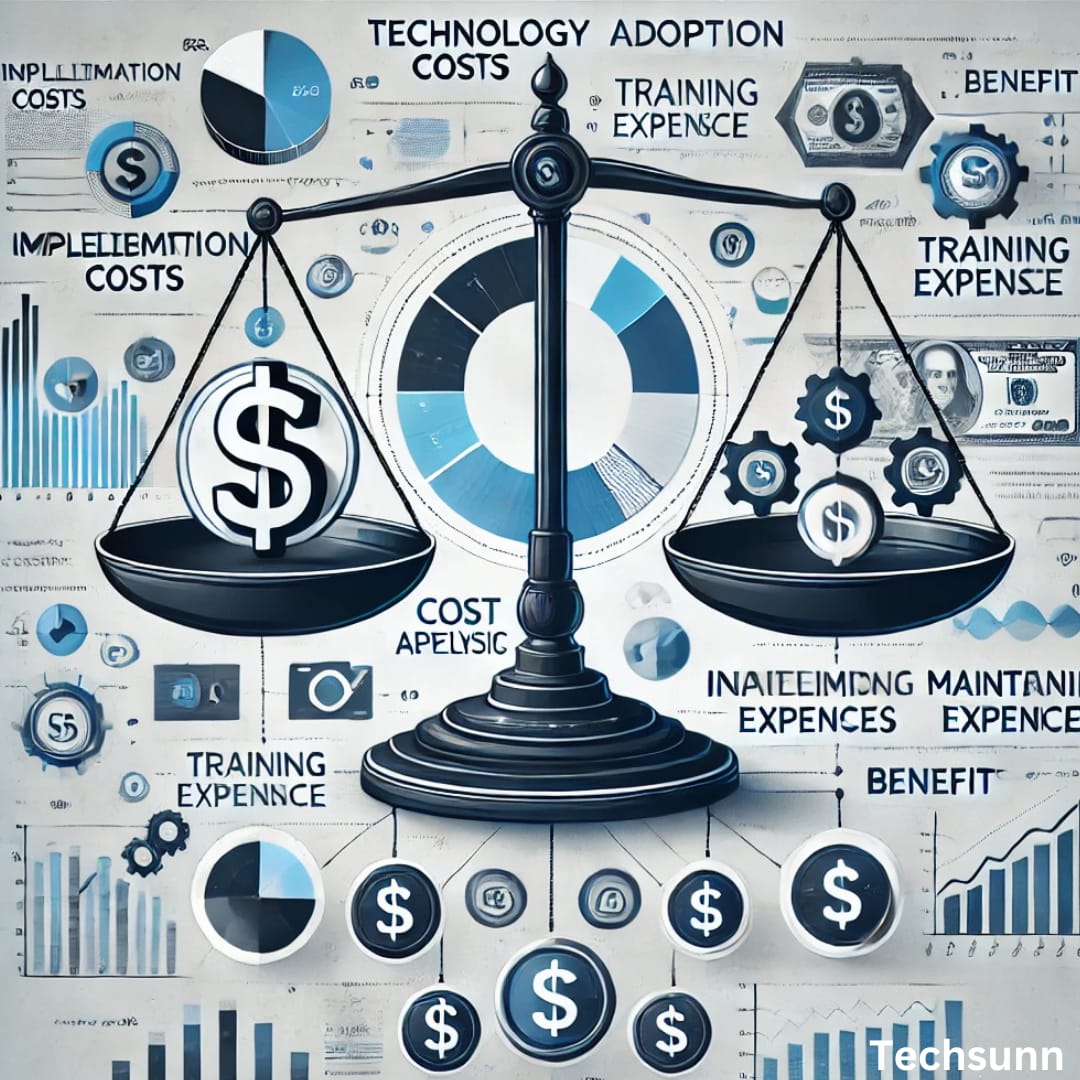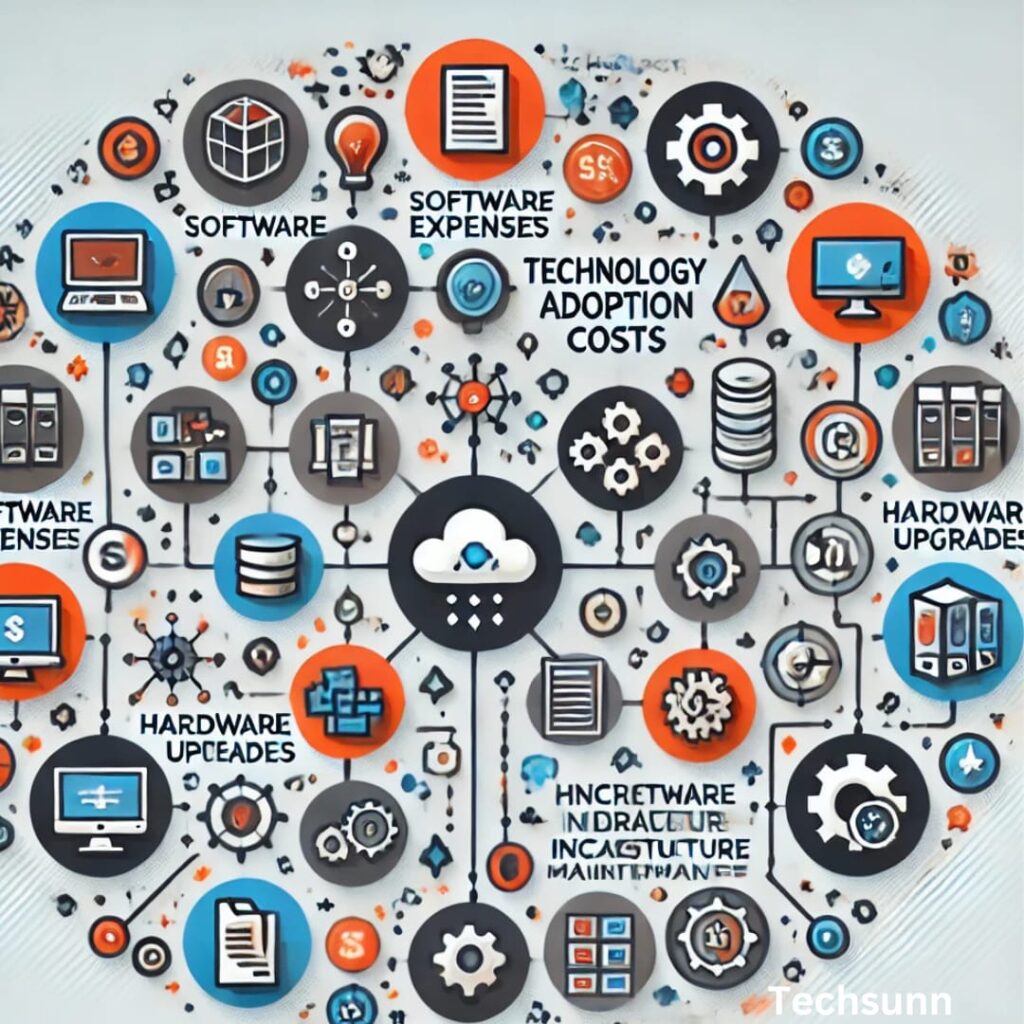Technology Adoption Cost Analysis

Introduction
As businesses continue to modernize, the adoption of new technologies has become more than just an option; it’s often essential for staying competitive and efficient. However, along with the advantages of advanced technology comes the challenge of evaluating the financial commitments involved. Technology adoption cost analysis is the method through which companies can fully understand, plan for, and manage the expenses associated with implementing new technology.
This article will delve into the components of technology adoption costs, from upfront investments to hidden and ongoing expenses. It will also discuss strategies to ensure a positive return on investment (ROI), providing organizations with a clear approach to evaluate, justify, and manage the costs of adopting new technology.
What is Technology Adoption Cost Analysis?
Technology adoption cost analysis is the systematic evaluation of all expenses incurred when implementing new technology. It includes direct costs, such as purchasing hardware or software, and indirect costs, such as training and maintenance. By understanding these expenses, companies can make more informed financial decisions about new technology investments.

Purpose of Technology Adoption Cost Analysis
- Informed Decision-Making: Helps businesses evaluate if the benefits of new technology outweigh the costs.
- Budget Planning: Identifies and anticipates all expenses, allowing for better budget allocation.
- Risk Management: Recognizes potential financial risks, such as hidden costs, that could affect the company’s financial health.
Key Components of Technology Adoption Costs
When adopting new technology, it’s essential to consider the full scope of costs involved. These can generally be categorized into three main areas: direct costs, indirect costs, and hidden costs.
Direct Costs
Direct costs are the expenses most easily identifiable when adopting new technology. They are typically initial, upfront investments required to acquire the technology.
- Hardware: Physical equipment such as computers, servers, and networking devices.
- Software Licenses: The cost of purchasing or licensing software, including one-time and recurring fees.
- Implementation Services: Includes setup, configuration, and consulting fees from vendors or third-party specialists.
Indirect Costs
Indirect costs support the adoption process but aren’t immediately apparent as purchase costs. They play a significant role in the total cost over time.
- Training: Employees may need training to learn and adapt to new technology, which can be time-consuming and costly.
- Maintenance and Support: Regular updates, repairs, and customer support ensure the technology functions smoothly over time.
- Downtime: Transitioning to new technology often leads to temporary productivity losses, which can impact company operations.
Hidden Costs
Hidden costs often arise unexpectedly and are overlooked in initial planning. Accounting for these costs can prevent financial strain later.
- Integration and Compatibility: Customization costs may be needed to make the technology compatible with existing systems.
- Productivity Losses: Employees need time to adjust to new systems, which can temporarily decrease output.
- Compliance and Security: Regulatory requirements, particularly in sectors like healthcare and finance, may involve additional costs for data security and privacy compliance.

Types of Technology Adoption Costs
Breaking down costs by type helps to prioritize and allocate resources effectively. Here are the main types of technology adoption costs.
Initial Setup Costs
- Acquisition Costs: The initial purchase price for hardware, software, or licenses.
- Installation and Configuration: Setup and installation fees, including any consulting services for deployment.
- Training Costs: Investments in employee training and onboarding to ensure they can use the technology efficiently.
Ongoing Operational Costs
- Subscription Fees: Monthly or annual costs for software as a service (SaaS) models or cloud-based solutions.
- Maintenance: Regular updates, technical support, and repairs.
- Utilities and Operational Overheads: Costs related to data centers, electricity, or other ongoing operational needs.
Upgrade and Scalability Costs
As companies grow, technology often needs to be scaled to accommodate increased demand.
- Upgrades: Costs of updating to new software versions or additional features.
- Scalability Expenses: Costs involved in expanding system capacity, such as increased storage or processing power, to support more users or larger data volumes.
Evaluating the Financial Impact of Technology Adoption
Evaluating the financial impact involves calculating the total expenses of technology adoption and comparing them to the anticipated benefits. Various financial models can assist in this process.
Cost-Benefit Analysis
A cost-benefit analysis helps businesses understand the value gained from technology adoption. This involves:
- Assessing Costs vs. Benefits: Calculate both the tangible and intangible benefits to compare against the total expenses.
- Payback Period: Determine the timeframe needed for the technology investment to generate enough value to cover its costs.
- Benefit-Cost Ratio (BCR): A comparison between the benefits and costs, indicating the potential profitability of the technology.
Break-Even Analysis
This analysis calculates when the financial gains from adopting technology will offset the initial and ongoing expenses.
- Break-Even Point: The moment when revenue generated from the technology covers its costs.
- Revenue Impact: Projects the long-term financial viability and helps assess if the technology will contribute to profit over time.
Factors Affecting Technology Adoption Costs
The expenses associated with technology adoption vary based on multiple factors, such as the size of the organization and the complexity of the technology.
Company Size and Industry
- Small Businesses: Often face higher per-user costs as they may not qualify for bulk discounts.
- Large Enterprises: May have lower costs per user due to economies of scale and bulk licensing options.
- Industry Requirements: Industries with strict regulatory standards, such as healthcare or finance, may have additional expenses related to compliance and security.
Complexity of Technology
Some technologies require specialized setup or training, leading to increased costs.
- Advanced Software: Complex software might need expert training and technical support.
- Integration Requirements: Complex systems that need to integrate with existing technology require more time and resources, raising costs.
Vendor and Subscription Costs
The cost of the technology depends significantly on vendor agreements and licensing models.
- Subscription vs. One-Time Fee: Subscription-based services may appear cost-effective initially but can add up over time.
- Vendor Support and Service Level Agreements (SLAs): Higher levels of support often come with premium charges, influencing the overall cost.

Calculating Total Cost of Ownership (TCO)
The Total Cost of Ownership (TCO) encompasses all expenses related to technology over its lifecycle, not just the upfront costs. This comprehensive approach provides insights into the long-term financial commitment.
Components of TCO
- Acquisition Costs: Initial investment, including hardware, software, and licenses.
- Operational Costs: Maintenance, support, and utility expenses over time.
- Downtime and Opportunity Costs: Financial impact of system downtime and potential losses from underutilized technology.
Calculating TCO gives a clearer financial picture of a technology investment and is essential for budgeting and financial planning.
Technology Cost Analysis Models
Different models help assess the financial impact of adopting new technology. Organizations can select the model that best aligns with their goals and resources.
Technology Cost Analysis Models
- Traditional TCO: Suitable for on-premises technology, which requires significant upfront investments but may have lower long-term costs.
- Cloud-Based TCO: Cloud solutions offer flexibility and lower upfront costs but have ongoing subscription fees, which can accumulate over time.
ROI and Payback Period Models
- ROI Model: Measures the return generated by technology relative to its costs, offering a percentage-based insight.
- Payback Period Model: Shows the time required to recoup the initial investment, helping businesses determine financial viability.
Using ROI to Measure Technology Adoption Value
ROI is a vital metric to evaluate the financial impact of new technology. It calculates the net gain or loss relative to the investment, helping businesses assess if the technology adds enough value to justify its costs.
Calculating ROI
The formula for ROI is:
ROI=(Total Benefits−Total CostsTotal Costs)×100\text{ROI} = \left( \frac{\text{Total Benefits} – \text{Total Costs}}{\text{Total Costs}} \right) \times 100ROI=(Total CostsTotal Benefits−Total Costs)×100
A positive ROI means the investment is profitable, while a negative ROI may suggest reconsidering the investment. Regular ROI evaluation helps ensure that the technology continues to offer value.
Conclusion
Technology adoption cost analysis is essential for businesses to navigate the complexities of implementing new systems effectively. By understanding and planning for direct, indirect, and hidden costs, companies can make informed decisions that align with their financial goals. Calculating TCO and ROI, assessing scalability, and managing hidden expenses contribute to maximizing the investment’s potential. For any organization, a thorough analysis of technology costs can lead to smarter investments, optimized budgets, and enhanced competitive advantages in the market.
FAQs
1. What are the main costs associated with technology adoption?
The primary costs include direct expenses (hardware, software), indirect costs (training, maintenance), and hidden costs (downtime, integration challenges).
2. How does Total Cost of Ownership (TCO) help in technology investment decisions?
TCO provides a comprehensive view of long-term expenses, helping companies understand the full financial commitment beyond initial costs, leading to more accurate budgeting.
3. What is ROI in technology adoption?
ROI measures the net benefit relative to the investment, helping businesses assess if the technology is financially advantageous.
4. How can companies reduce technology adoption costs?
Companies can minimize costs by negotiating vendor terms, using open-source alternatives, implementing phased rollouts, and conducting regular cost reviews.
5. Is cloud-based technology cheaper than on-premises solutions?
Cloud solutions have lower initial costs and offer flexibility, but subscription fees can add up over time.




